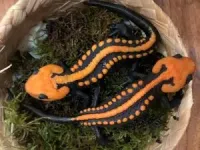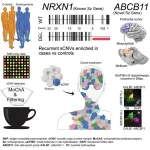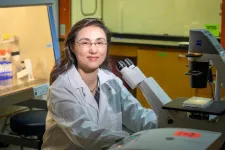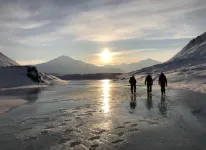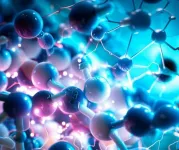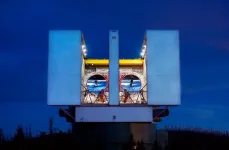(Press-News.org) In 985, Viking explorer Erik the Red led a group of Icelandic farmers to Greenland, where they established a settlement on the west coast. Archaeological evidence suggests that the settlement existed for over 400 years, but the impact of the settlement lasted much longer. It is little recognised today that the hope of finding the descendants of the settlers dominated European and American perspectives on Greenland for centuries
In his new book The Vanished Settlers of Greenland: In Search of a Legend and Its Legacy, Associate Professor Robert Rix argues that the lost Norse settlement played a decisive role in Denmark’s efforts to colonise Greenland during the 18th century.
“Like other New World lands, Greenland became part of European history as a place where a hunt for resources took place. Denmark's possession of Greenland and its waters was challenged especially by the Dutch and the English. Danish claims to the island relied in large parts on the memory of the settlers. Therefore, several manuscripts, books, and maps were produced not only reminding competitors of the settlers but also promoting the idea that their descendants were still cultivating Greenland fields,” says Robert Rix.
He adds:
“The loss of communication with Norse Greenland in the early 15th century gave rise to speculations about the settlers’ fate, and many believed that the settlement still stood. This led to numerous attempts at contacting them, not least because rumours of the settlement’s wealth were circulating in European books. King Christian IV launched as many as three expeditions to look for the vanished settlers and their riches.”
The actual colonisation began in 1721 with the establishment of a colony by missionary Hans Egede, who wanted to convert the Inuit to Christianity and to finance the colony by reconnecting with the Norse settlement and exploiting its resources.
The fantasy of an unspoilt Norse civilisation
Just as other expeditions before his, Egede’s failed to locate the Norsemen, and during the 19th century people began to accept that the Norse settlers were no longer to be found in Greenland.
“Instead, scientists and explorers turned their attention to other parts of the Arctic as potential locations where the vanished settlers might have emigrated. Between 1870 and 1920 this inspired the publication of many adventure stories about isolated colonies of Norsemen, supposed descendants of the bold Viking explorers, who were strong, healthy, and physically impressive,” remarks Robert Rix.
According to Rix, the wide fascination with the Norse settlers in Western culture reflected public anxieties about the detrimental effects of immigration and the decline of civilisation.
“This fantasy is in line with a general critique of supposedly impure societies, which gained prevalence with the advent of eugenics. The fictional Arctic colonies had become communities frozen in time that served as an antidote to the cultural and physical decline of modernity.”
Well into the 20th century, it was hoped that the descendants of the settlers could be found. On a 1912 expedition to Canada’s Victoria Island, the explorer Vilhjalmur Stefansson discovered Inuit of a slender build and red-brownish hair. He measured their heads and came to the conclusion that they were descendants of the European settlers who had survived by mixing with the Indigenous population.
The existence of ‘Blond Eskimos’ became a huge media sensation. Modern DNA analysis has disproven any Norse ancestry, but at the time Stefansson’s claim rekindled the old hope that the mystery of the vanished settlers’ fate could be solved.
The Vanished Settlers of Greenland: In Search of a Legend and Its Legacy has been published by Cambridge University Press.
END
Legends of Norse Settlers drove Denmark towards Greenland
The Danish colonisation of Greenland in the 18th century was in part driven by the desire to re-establish contact with early Norse settlers that vanished from the island in the course of the 15th century
2023-07-06
ELSE PRESS RELEASES FROM THIS DATE:
Archaeology: The power of the Copper Age 'Ivory Lady' revealed
2023-07-06
The highest status individual in ancient Copper Age society in Iberia, was a woman and not a man as previously thought, according to peptide analysis reported in Scientific Reports. The individual, now re-dubbed the 'Ivory Lady', was buried in a tomb filled with the largest collection of rare and valuable items in the region, including ivory tusks, high-quality flint, ostrich eggshell, amber, and a rock crystal dagger. These findings reveal the high status women could hold in this ancient society.
In 2008, an individual was discovered in a tomb in Valencia, Spain dating to the Copper Age between 3,200 and 2,200 years ago. As well as being a rare example of a single occupancy ...
Schizophrenia is associated with somatic mutations occurring in utero
2023-07-06
As a psychiatric disorder with onset in adulthood, schizophrenia is thought to be triggered by some combination of environmental factors and genetics, although the exact cause is still not fully understood. In a study published in the journal Cell Genomics on July 6, researchers find a correlation between schizophrenia and somatic copy-number variants, a type of mutation that occurs early in development but after genetic material is inherited. This study is one of the first to rigorously describe the relationship between somatic—not inherited—genetic mutations and schizophrenia risk.
“We originally thought of genetics as the study of inheritance. But now we ...
Team develops all-species coronavirus test
2023-07-06
CHAMPAIGN, Ill. — In an advance that will help scientists track coronavirus variants in wild and domesticated animals, researchers report they can now detect exposure to the SARS-CoV-2 virus in any animal species. Most coronavirus antibody tests require specialized chemical reagents to detect host antibody responses against the virus in each species tested, impeding research across species.
The virus that causes COVID-19 in humans also infects a variety of animals, said University of Illinois Urbana-Champaign pathobiology professor and virologist Ying Fang, who led the new research. So far, ...
Shrinking Arctic glaciers are unearthing a new source of methane
2023-07-06
As the Arctic warms, shrinking glaciers are exposing bubbling groundwater springs which could provide an underestimated source of the potent greenhouse gas methane, finds new research published today in Nature Geoscience.
The study, led by researchers from the University of Cambridge and the University Centre in Svalbard, Norway, identified large stocks of methane gas leaking from groundwater springs unveiled by melting glaciers.
The research suggests that these methane emissions will likely increase as Arctic glaciers retreat and more ...
Health outcomes, cost-effectiveness of monoclonal SARS-CoV-2 antibodies as pre-exposure prophylaxis
2023-07-06
About The Study: This decision analytic model showed that within the context of a high SARS-CoV-2 probability, monoclonal antibodies pre-exposure prophylaxis (mAbs PrEP) provision was cost-saving when provided to individuals at increased risk of severe COVID-19 if drug prices decrease to $275 and effectiveness is 75% or higher. When newer mAbs PrEP combinations become available, guidance on implementation should be formulated ensuring a fast rollout. Nevertheless, advocacy for mAbs PrEP use and critical discussion on drug prices are necessary to ensuring cost-effectiveness for different epidemic settings.
Authors: Stephanie Popping, M.D., Ph.D., of the University ...
Hearing loss and fatigue in middle-age and older adults
2023-07-06
About The Study: Hearing loss was cross-sectionally associated with higher frequency of fatigue after adjustment for demographics, lifestyle factors, and comorbidities in this nationally representative sample of middle-age and older adults. Future studies with fatigue assessments capturing its multidimensionality are needed to understand how hearing loss might contribute to physical and mental fatigue differentially and clarify how hearing loss may be associated with downstream outcomes like physical impairment through fatigue.
Authors: Nicholas ...
Scientists develop strategy to engineer artificial allosteric sites in protein complexes
2023-07-06
According to a recently published research paper by a team of scientists, a groundbreaking approach has been developed to create artificial allosteric sites (where by binding an effector molecule, activity at the distal active site is regulated) in protein complexes. This breakthrough research holds significant promise for a wide range of applications in industrial, biological, medical, and agricultural fields.
The team’s work is published in Nature Chemistry on 06 July 2023 at 16:00 (London time)
Protein complexes, such as hemoglobin and molecular motors, ...
New study shatters conventional wisdom and unlocks the future of electrochemical devices
2023-07-06
A new study by researchers at the University of Cambridge reveals a surprising discovery that could transform the future of electrochemical devices. The findings offer new opportunities for the development of advanced materials and improved performance in fields such as energy storage, brain-like computing, and bioelectronics.
Electrochemical devices rely on the movement of charged particles, both ions and electrons, to function properly. However, understanding how these charged particles move together has presented a significant challenge, hindering progress in creating new materials for these devices.
In ...
Study examines centuries of identity lost because of slavery
2023-07-06
Many Americans can trace some lines of their family tree back to the 1600s. However, African Americans descended from enslaved Africans, who began arriving in North America in 1619, lack ancestral information spanning several centuries.
A new USC and Stanford study, recently published in Genetics, provides insight into who occupies these missing branches of family trees — and gives a glimpse of how many branches there are.
“Slavery was not that many generations ago, so my family still tells stories about our enslaved ancestors, like who they were and, in my case, how we ended up as light as we are,” said first author Jazlyn Mooney, the Gabilan Assistant Professor of Quantitative ...
Astronomers discover elusive planet responsible for spiral arms around its star
2023-07-06
Depictions of the Milky Way show a coiling pattern of spiral "arms" filled with stars extending outward from the center. Similar patterns have been observed in the swirling clouds of gas and dust surrounding some young stars – planetary systems in the making. These so-called protoplanetary disks, which are the birthplaces of young planets, are of interest to scientists because they offer glimpses into what the solar system may have looked like in its infancy and into how planets may form in general. Scientists have long thought that spiral arms in these disks ...
LAST 30 PRESS RELEASES:
Sweeping study shows similar genetic factors underlie multiple psychiatric disorders
How extreme weather events affect agricultural trade between US states
Smallholder farms maintain strong pollinator diversity – even when far from forests
Price of a bot army revealed across hundreds of online platforms worldwide – from TikTok to Amazon
Warblers borrow color-related genes from evolutionary neighbors, study finds
Heat signaling from plants is an ancient pollinator signal
New index reveals the economics underlying the online manipulation economy
High-resolution satellite observations reveal facility-level methane emissions worldwide
Researchers discover how Ebola and Marburg disrupt the gastrointestinal tract
Feeling the heat
Eastward earthquake rupture progression along the Main Marmara Fault towards Istanbul
Scientists uncover how Earth’s mantle locked away vast water in early magma ocean
Scientists uncover key driver of treatment-resistant cancer
Rare image of Tatooine-like planet is closest to its twin stars yet
Music: Popular song lyrics have become more negative since 1973
Marine ecology: Killer whales tail dolphins to hunt salmon
ADHD prescriptions on the rise, study finds
How to build a genome
Sharp rise in ADHD stimulant prescriptions in Ontario, research finds
Trends and prevalence of the metabolic syndrome among US adults
Population-level trends in ADHD medication prescribing
Missing piece of myelin disturbs the brain’s rhythm
Insilico Medicine and Taigen achieves license agreement to develop and commercialize AI-driven PHD inhibitor for anemia of Chronic Kidney Disease (CKD)
Exploring dominant endophytic Pleosporales in grasses: New taxonomic insights in the suborder Massarineae
Comparative transcriptomic analysis of human maxillary and mandibular tooth germs reveals discrepancies in gene expression patterns
Scientists detect atmosphere on molten rocky exoplanet - study
Chip-scale magnetometer uses light for high-precision magnetic sensing
Illinois Tech biomedical engineering professor Philip R. Troyk elected as Fellow of the National Academy of Inventors
The National Academy of Inventors welcomes 2025 Class of Fellows
Multi-scale modelling framework predicts mechanical responses of Fe–Cr–Al alloys across composition and processing conditions
[Press-News.org] Legends of Norse Settlers drove Denmark towards GreenlandThe Danish colonisation of Greenland in the 18th century was in part driven by the desire to re-establish contact with early Norse settlers that vanished from the island in the course of the 15th century

